Tabletop Tripod Comparison
Any number of companies sell cheap tabletop tripods, but only a
few of the more expensive ones are sturdy enough to hold heavier
cameras. I decided to try some of them out and see how they compared.
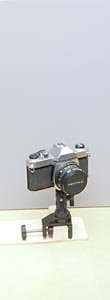
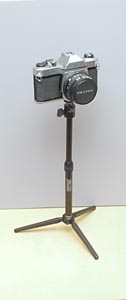
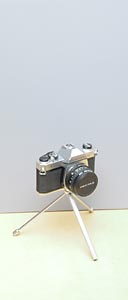

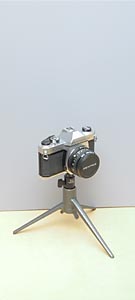
Weights are approximate, prices are subject to change.
(If this text is too small, increase the default font size in your
browser.)
|
| Photo |
Name |
Model # |
B&H Stock # |
Cost |
Weight |
Weight |
 |
Bogen
(legs only) |
3007 |
BO3007 |
$15 |
3.5oz |
99g |
| --- |
Bogen extender
(shown above) |
3007x |
BO3007X |
$18 |
3oz |
85g |
 |
Minox |
69309 |
MITPC |
$90
($50+ used) |
4oz |
113g |
 |
Basicball (blue) |
BBBLAU |
NOBBB |
$68 |
13.5oz |
382g |
| --- |
Basicball
Leg Extenders |
MPSET15 |
NOE6 |
$39 |
? |
? |
 |
Leica |
14100 |
LETT |
$80
($50+ used) |
7oz |
198g |
 |
Ultrapod |
PD01020 |
ULUP1B |
$15 |
2oz |
57g |
 |
Ultrapod II |
PD02010 |
ULUP2B |
$19 |
4oz |
113g |
| --- |
Giotto
Compact Tripod |
400200 |
GICTT |
$30 (w/head) |
? |
? |
 |
Thread Adapter
3/8 to 1/4 |
Bogen
3358 |
BO3358 |
$4.50 |
0.5oz |
14g |
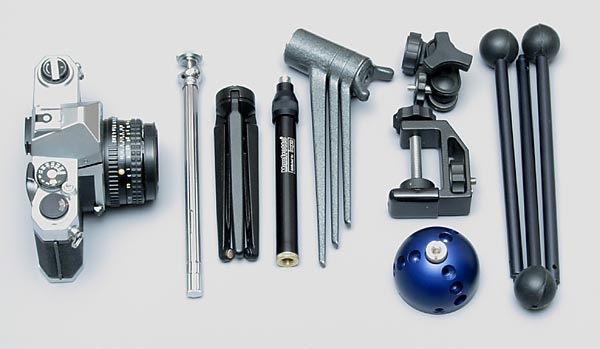
Here they are all folded up.
Left to right: Minox, Bogen (legs & extender),
Leica, Ultraclamp, Basicball.
The Bogen, Leica, and Basicball require a separate ballhead.
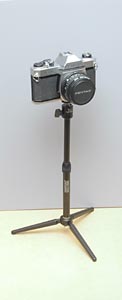
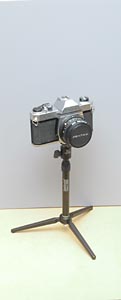
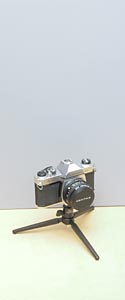
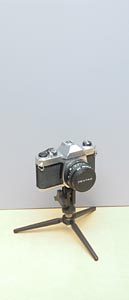

The first thing you probably want to know is, now that I've tried
all this stuff, what do I actually use? My vote goes to the Bogen
3007 with the extender, and the Ultraclamp. When I'm traveling
light, I use the Bogen legs with the ball joint from the
Ultraclamp (with a thread adapter, 4th photo above), so I don't
have to carry the extender or a separate ballhead. The Ultraclamp
is relatively cheap and available at most camera stores, so I'd
start with that. The Bogen legs are often bundled with the
extender and/or a ballhead; I recommend buying the extender but
you may want to select your own head. (The Giotto tripod listed
above is a similar design, but I don't see any reason to choose
it over the Bogen. See B&H's website for a photo.)
All Bogen products are made by Manfrotto, and are sold under the
Manfrotto name (with different part numbers) outside the US.
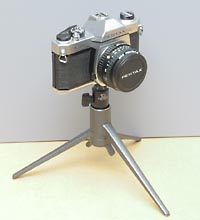
|
Many photographers recommend the Leica tripod, because it's been
in production for many years and they're familiar with it. It's
sturdy and about the same weight as the Bogen with the extender,
but it's very expensive and it folds to an awkward shape. Used
ones show up on ebay fairly often, but they can still cost twice
as much as the Bogen. You may see older versions that have
slightly different castings, and are painted black instead of
gray. Also, it's supposed to have rubber feet, but they're often
missing (and not really needed). Leica makes an extra-tall
ballhead specifically for this tripod (not shown here, I'm using
a generic cheap ballhead), but again it's expensive.
A number of companies make tripods that are similar to the Leica
design, at various levels of quality (and usually including a
ballhead), but there are too many of them to list here.
|
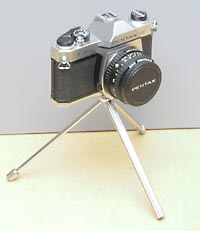

The Minox tripod is a very clever design, and it's extremely
compact (the two detatchable legs fit inside the largest leg),
but also very expensive. It's sturdy enough for a full-sized SLR,
but I had trouble getting the built-in ballhead really tight,
which could be a problem with heavy lenses. The head is tightened
by turning the largest leg, and it has a slot to insert a coin
for extra leverage.
Sometimes you'll see used ones being sold with a special clip
to hold the Minox "spy" camera, but it's just screwed onto the
head, and is easily removed. There is also a small cable release
screwed into the end of the smallest leg, but it has a very short
stroke-- adequate for the Minox camera, but not long enough to
trigger my SLR (which may explain why it's often missing).
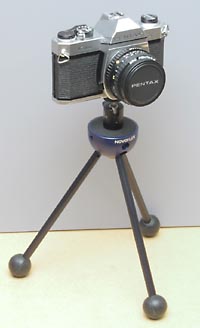
|
For the heaviest cameras, look at the Novoflex Basicball-- it's
rated to hold 25Kg, which is over 50lbs! It also weighs (and
costs) twice as much as the Bogen with the extender. The head
shown here is not included (a bigger one would fit better). The
thread is 1/4-20 rather than the usual 3/8-16, but most heads
come with an adapter. It also comes in silver, but for some
reason B&H stocks it in blue.
You could get a used Leica tripod for less, but the Basicball is
taller, and has extra threaded holes for attatching light
brackets, which might be especially useful for macro work. They
also make a set of leg extenders to make it even taller. It can
be made lower/wider by screwing the legs into different holes in
the ball.
|
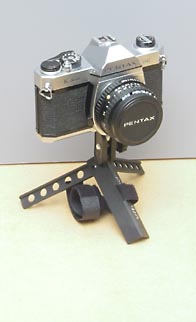
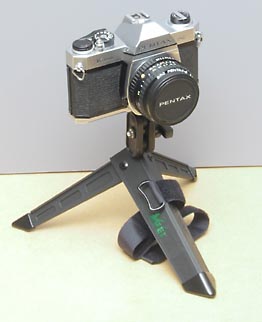
The Ultrapod and Ultrapod II are clever designs but the legs flex
more than I'd like them to. Their claim to fame is that they come
with a velcro strap to attatch them to objects that are too large
for the Ultraclamp or the Super Clamp (with the legs folded in).
The ball joint is permanently attatched, but it's similar to the
one that comes with the Ultraclamp.
Clamp-pods
| Photo |
Name |
Model # |
B&H
Stock # |
Cost |
Weight |
Weight |
 |
Ultraclamp |
PD05020 |
ULUC |
$22 |
5.5oz |
156g |
 |
Super Clamp (w/stud) |
2909 |
BO2909 |
$27 |
17oz |
482g |
 |
Rt Angle Arm (w/stud)
For Super Clamp |
2906 |
BO2906 |
$18 |
6.5oz |
184g |
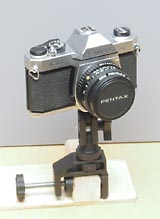
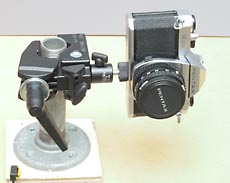
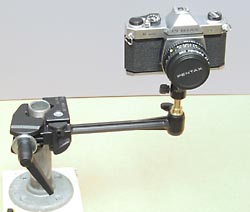
The Super Clamp weighs three times as much as the Ultraclamp, but
it's very sturdy (it was originally designed to hold studio
lighting). The optional right-angle arm is heavy and expensive,
but I've found it useful. The Super Clamp has interchangeable
mounting studs (not visible here) for attatching a separate
ballhead, and it's sometimes bundled with different studs for
different purposes-- if you buy one on the web, read the
description to make sure you know which mounting stud you're
getting.
Click here to see Bogen's brochure
showing how the various accessories are used (print this in
landscape mode as "fit to page"). Most Super Clamp components are
also sold under the "Avenger" name, with different part numbers.
The Super Clamp can attatch to round objects up to 2" in
diameter, or flat objects up to 1.5" thick. The ultraclamp is
limited to 1.5" diamater, round or flat.
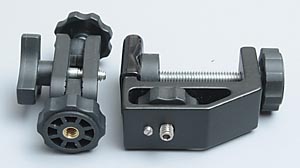
|
The Ultraclamp has a small screw under the ball joint that keeps
it from rotating unless you loosen the thumbscrew underneath.
This screw can be removed to install other heads, but be careful
not to lose it.
The threads are 1/4-20.
|
Articulating Arm Systems
| Photo |
Name |
Model # |
B&H Stock
# |
Cost |
Weight |
Weight |
 |
Bogen
Articulating Arm |
2935 |
BO2935 |
$33 |
20oz? |
567g? |
| --- |
Bogen
Magic Arm |
2930 |
BO2930 |
$105 |
? |
? |
| --- |
Bogen
Variable friction Arm |
2929 |
BO2929 |
$90 |
? |
? |
 |
Edmund/PanaVise
Articulating Arm Set |
F53-885 |
--- |
$39 |
15oz |
425g |
 |
Edmund/PanaVise
"Knuckle" (ballhead) |
F53-887 |
--- |
$16 |
5.5oz |
156g |
 |
Edmund/PanaVise
3" Arm |
F53-888 |
--- |
$10 |
3oz |
85g |
| --- |
Edmund/PanaVise
6" Arm |
F53-889 |
--- |
$11 |
6oz |
170g |
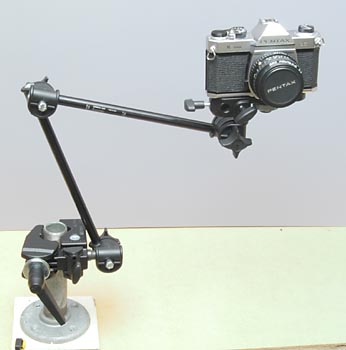
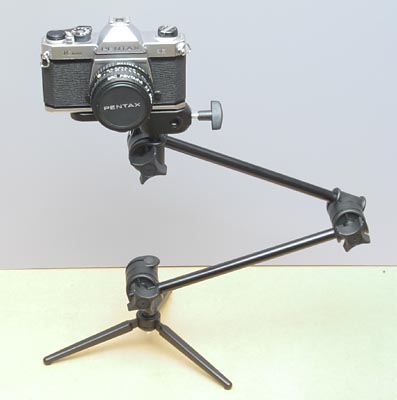
The "Magic Arm" and its variants are designed to hold a camera in
unusual positions where you can't get a tripod or Super Clamp
close enough. The long arms flex more than I'd like them to, but
it might work OK with the self-timer. The "Articulating Arm"
(shown here) has three separate joints; the more expensive "Magic
Arm" has a single lever than tightens all three joints at once
(but when you loosen it, the whole thing goes limp); the
"Variable Friction Arm" is similar to the "Magic Arm" but can be
partially tightened to make it easier to adjust (and for some
reason it costs $15 less than the Magic Arm).
In some cases I have improvised camera supports from scrap
lumber, using either the Ultraclamp (or Super Clamp), or just a
1/4-20 bolt through a hole to attatch a ballhead. Depending on
what you're doing, this might be more rigid than the Magic Arm.
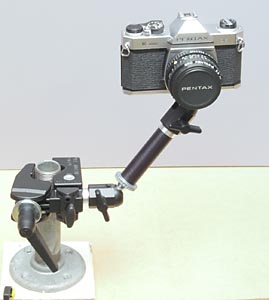
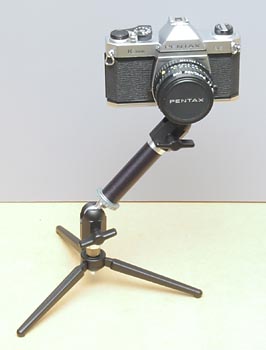
The articulating arm components from
Edmund Optics
(actually made by
PanaVise)
are an interesting alternative to the Magic Arm. They're heavy
but the arms are shorter (and detatchable), so they don't flex as
much, and I've found them easier to work with (they were designed
to hold surveillance cameras). They're cheaper than the "Magic
Arm", about the same cost as the "Articulating Arm". Threads are
1/4-20; I used an adapter to mount it to the Bogen legs in the
photo.
Other lessons learned:

|
All threaded connections must be tight enough so that they don't
come unscrewed when you don't want them to. I carry a pair of
miniature "Channel Lock" (brand name) pliers to make sure I can
get them apart again afterwards.
|
|
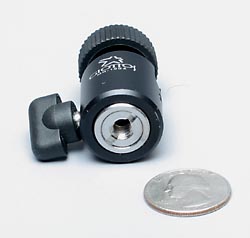
|
The standard mounting thread for
tripod heads is 3/8-16, but many ball heads come with an adapter
to use on 1/4-20 threads. It looks like you could remove it with
a large screwdriver, but I've found that a coin fits better.
|
No tripod is perfectly stable, so use the self-timer or a cable
release.
The "wall-pod" idea (holding a tabletop tripod sideways
against a wall) works very well, and is a good way to get some
extra height without carrying a full sized tripod. Be sure to
hold the tripod and not the camera, so you don't accidentally
move something.
A "clamp-pod" is only as stable as the object it's clamped to. If
it moves or sways when you lean on it, be careful! In such cases,
I've found that the 10-second self timer works better than the
2-second self timer, because it gives things more time to settle
down (but a real tripod works even better). "Clamp pods" do work
well when they're clamped to something stable. There are a number
of other clamp-pods on the market, but they tend to be expensive
and they're not any better than the Ultraclamp and/or Super Clamp.
The Bogen 3/8-to-1/4 thread adapter listed in the chart at the
top of this page doesn't always come up on B&H's search results,
depending on what keywords you use. Try searching for "euro
adapter", or type in the stock # listed above.
Click here to contact me
Index Page







































